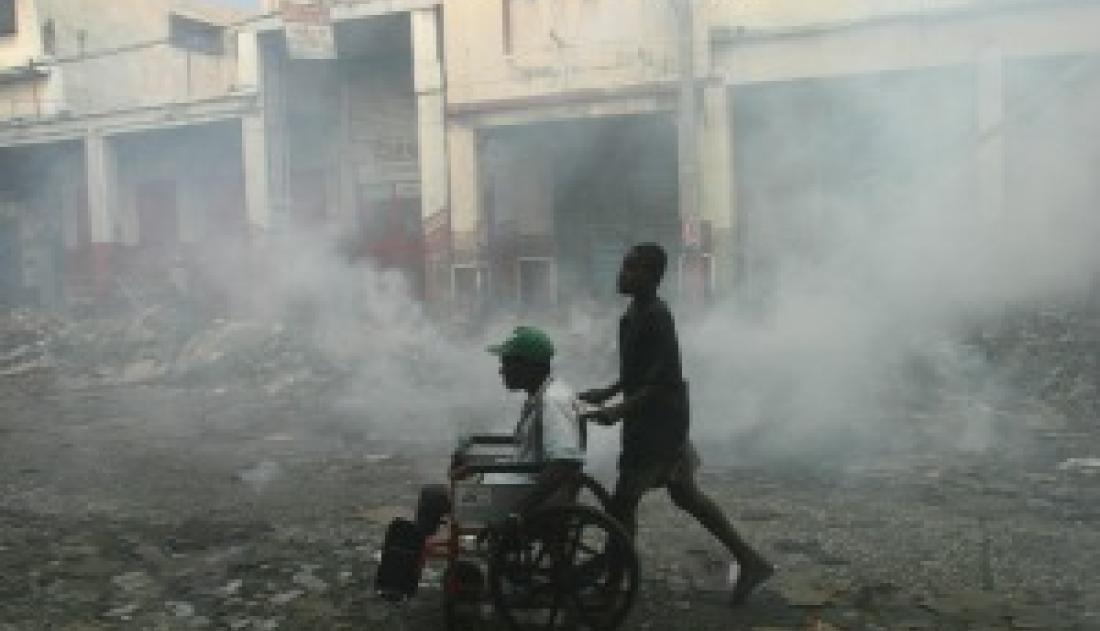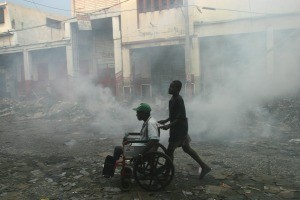
Japan earthquake
A series of earthquakes and aftershocks has hit Kumamoto Prefecture on Kyushu Island in southern Japan since 14 April, including a 6.5 magnitude tremor on 14 April, a 7.3 magnitude that hit on 16 April and a 5.8 magnitude tremor on 18 April. As of 19 April morning, authorities confirmed 44 fatalities due to the earthquakes, over 1,100 people injured and eight people still missing. An estimated 94,160 people continue to shelter in 1,021 evacuation centers in Kumamoto, Oita, Fukuoka and Nagasaki prefectures. (OCHA)
In Kumamoto, 37 facilities designated as welfare evacuation centers by the city government admitted evacuees with disabilities or with special needs. As of 26 April, 188 persons with disabilities and elder persons were staying in the centers, comparing to 1700 persons the city government of Kumamoto expected. (The Japan News)
Some facilities have accepted persons with disabilities voluntarily. For example, the Kumamoto Gakuen University in Chuo Ward, Kumamoto, opened its campus, equipped with barrier-free entrances and multipurpose restrooms, starting on April 15. The school has accepted about 60 people. Teachers, students and volunteer workers are providing assistance for evacuees with special needs. (The Japan News)
Ecuador earthquake
Two days after the earthquake in Japan on Saturday 16 April 2016, a 7.8 earthquake (Richter scale) hit Northern Ecuador at 18:58 local time. As of 21 April, 587 people are reported dead, 155 are missing and 8,340 are injured. Additionally, 25,376 people are in collective shelters. (OCHA)
According to the report of the National Secretariat for Risk issued by 13:00, April 25, 2016, 840 people with disabilities were identified in the Ecuadorian province of Esmeraldas and Manabi. Of that total, 268 people are in shelters and 126 foster homes. (Ecuador Times) As of 3 May, 1,412 persons with disabilities have been identified in Manabí, noted by the Technical Secretariat for the Inclusive Management on Disabilities (SETEDIS) of the Vice Presidency of the Republic of Ecuador.
Disability and emergency situations
Common experience reveals that persons with disabilities are more likely to be left behind or abandoned during evacuation in disasters and conflicts due to a lack of preparation and planning, as well as inaccessible facilities and services and transportation systems. Most shelters and refugee camps are not accessible and people with disabilities are many times even turned away from shelters and refugees camps due to a misleading perception that they need “complex medical” services.
At the Third World Conference on Disaster Risk Reduction (3WCDRR) convened in Sendai in March 2015, the international community made a big step forward in mainstreaming disability in development agenda and processes. The Sendai Framework specifically includes a call for a disability perspective to be integrated into disaster risk reduction, and of the strengthening of social mechanisms to assist persons with disabilities during such times.
The success of Sendai left an important legacy and vital influence and impact on disaster risk reduction and humanitarian actions for persons with disabilities. In the guidance of the Sendai Framework, a number of disabled peoples’ organizations and civil society organizations have responded to the earthquakes in Japan and in Ecuador to provide relief and recovery services that are accessible to persons with disabilities and other at-risk people in the affected communities.
For example, in Japan, a survey will be conducted to ascertain the needs of, and support will be provided to, persons requiring special consideration, including persons with disabilities, older persons, and young children. The Nippon Foundation has established a Disaster Response Support Center Kumamoto Office for the unified management of needed support, to ensure that relief and reconstruction activities by NGOs, volunteers, companies, and other private-sector organizations are carried out smoothly in coordination with related government agencies.
In Ecuador, The ongoing process of identification and geo-location of persons with disabilities in the areas affected by the earthquake is being led by the SETEDIS. 157 volunteers including psychologists, physicians, medical emergency technicians, nurses, and Inclusive Disaster Risk Management specialists, are working in the most affected zones in the cities of Portoviejo, Manta, Chone, Calceta, Crucita, Jama and San Vicente. These volunteers have visited hospitals, homes, and shelters to gather the following information about persons with disabilities: current location, mobility situation, requirement of technical aids, and the condition of homes, among other items. The aim of this activity is to coordinate actions with emergency agencies and to support the Armed Forces and the Ministry of Health, respectively, in the delivery of humanitarian aid and of technical aids to persons with disabilities.
Actions were also taken by community stakeholders and development partners such as Christian Blind Mission (CBM) who is currently working on empowerment of persons with disabilities in Community Based Rehabilitation, and mainstreaming disability, and located in the provinces of Esmeraldas, Guayas, and Loja. CBM responses will aim to ensure that persons with disabilities (and other more at-risk people in the affected communities) can access mainstream relief and recovery services and, simultaneously, that any specific needs are met.
Read more:
Temporary shelters will meet accessible requirements (SETEDIS)
Model accessible shelter used for the humanitarian actions in Ecuador (SETEDIS)
Productive Inclusion and Universal Accessibility: Alternatives for development in the aftermath of the earthquake in Ecuador (SETEDIS)
Improved system needed to assist disabled people in disasters (The Asahi Shimbun)
Response to the 2016 Kumamoto Earthquake (Nippon Foundation)
Ecuador earthquake (CBM)
Questions and answers on the April 2016 Ecuador Earthquake (CBM)
Disability-Inclusive Disaster Risk Reduction and Emergency Situations
Disability-inclusive Humanitarian Action
Sendai Framework for Disaster Risk Reduction 2015-2030
Taking action toward a disability-inclusive disaster risk reduction framework and its implementation
Inclusion Saves Lives: Did you successfully overcome a natural disaster or emergency situation? Tell us your story!
 Welcome to the United Nations
Welcome to the United Nations



